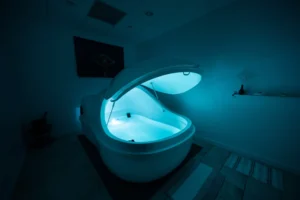Jess Campbell | Sep 13, 2023
Float tanks prove a salve for the malaise of modern life, with an hour of floating sleep being compared to four hours of normal sleep.
IF IT FEELS like you’re playing catch up on a year’s worth of sleep, you’re not alone. According to reports, up to 40 per cent of Aussies are unable to get seven to nine hours of sleep each night, with 59.4 per cent of the population experiencing trouble falling asleep, staying asleep and waking too early. It’s this desire for some shut eye that has led many to discover the benefits of float tanks and floatation therapy. Though not a new concept, it’s a trend that has staying power as far as the wellness industry is concerned. With benefits ranging from improved sleep quality, relaxation and cardiovascular health, float tanks are fast amassing an audience of devoted followers.
But unlike a sauna or fitness centre whose various activities you can see, for newcomers, ventures into floatation therapy appear like something out of a fantasy novel. Dark, devoid of all stimuli, with some magical liquid that sees you recline effortlessly atop the surface. What is this sorcery! The benefits might prove magical, but the practice itself is nothing to be alarmed about. Rather, for those looking for a stress reliever and antidote to lack of sleep, float tanks might just become your newest wellness passion.
What is float therapy?
Otherwise known as isolation tank or floatation tank, floatation therapy involves a sensory deprivation tank you enter for relaxation, stress management pain relief, and—in some instances—creative inspiration. Unlike a spell cast from a wand wielded by a Hogwarts alumni, float therapy works thanks to 800kg of Epsom salt and magnesium sulphate, allowing you to float effortlessly while also providing relief to any muscle aches and pains.
The density of saltwater creates the illusion of zero gravity and, at least for the duration of your time in the float tank, you’ll feel completely at ease, your muscles unfurling with each breath. The overall effect is one of deep relaxation and a state of meditated bliss. You’ll likely emerge feeling calm and refreshed, all of which can enhance recovery.
What are the benefits of float tanks?
In our current climate, it’s hard not to feel daily stress compound. From work duties, our personal relationships, and social obligations, we’re a society that wears the phrase ‘I’m too busy’ like a badge of honour, rushing from one meeting to the next, unwilling to give ourselves a break to reset, refresh and recalibrate. For avid supporters of float therapy, the main benefit they celebrate is that of reduced stress. Magnesium, a natural stress reliever, is lost in the body from excess adrenaline and float therapy provides the chance for our bodies to slow down and relax.
Improved cardiovascular health:
Along with better sleep, floatation therapy also helps to improve cardiovascular health as it lowers blood pressure and increases the dilation of blood vessels, leading to improved blood flow to your body.
Reduced aches and pains:
Thanks to the magnesium sulphate and Epsom salts, your body is allowed to float with no strain on any muscles. For many, it’s an experience that has helped reduced back pain and muscle tension.
Are float tanks clean?
If you think you’ll be floating in someone else’s filth, think again. Float tanks house the cleanest possible water, thanks to the high volume of Epsom salt that’s dissolved in the pod. In fact, the solution is so high in saline that no living microorganism can survive in there, meaning any fears of bacteria or germs are quashed. After each session, the entire volume of the solution is pumped out and filtered through a complex three-part filtration and sterilisation system using Ultra Violet light to maintain the water’s clean appearance. As well as this, the shower prior to the float tank ensures all clients are clean before entering.
Can anyone do floatation therapy?
As is always the case when trying something new, it’s best to consult with a doctor should you have any medical concerns. That said, it’s advised that those who have kidney impairments avoid float tanks due to the magnesium absorbed, along with those who have wounds or injuries on their bodies. Those who suffer from extreme anxiety and claustrophobia might also wish to avoid float tanks as they could prove triggering. It’s also suggested that those who suffer from vertigo, tinnitus, or are prone to ear infections also avoid floatation therapy.
Is it normal to fall asleep in a float tank?
If, like most of us, you struggle to get enough sleep, float tanks might just be your saving grace. In fact, supporters of floatation therapy compare an hour of floating sleep to four hours of ordinary sleep due to the soothing nature of the session which enhances sleep quality. Not surprisingly, many people fall asleep during a treatment as they find their mind and body at rest.
How do you protect your hair in a float tank?
For all the benefits of float tanks, there’s the ole caveat: what about my hair? Understandably, the high levels of salt can damage the hair’s protective seal and leave it looking (and feeling) dry, but it’s not all bad news. Saltwater has been shown to act as an exfoliant of sorts, reducing build-up that can contribute to dandruff on the scalp. If you have coloured or treated hair, consider using a mask post-float session that you can apply in the shower after your treatment.
What can you expect for your first time in a float tank?
Coming face-to-face with a circular pod filled with water and heated to your body temperature might seem daunting, but there’s little to be nervous about. Entry into the float tank is easily accessible and many choose to float with the lid open for a more comfortable, pleasant experience. As you adjust to floatation therapy and become more accustomed to the practice, then you can look at closing the lid and really diving deep into that relaxation.
Before you enter the pod, you’ll remove all clothing and jewellery and have a shower. Then, you’ll put in earplugs and enter the tank, closing the door to keep light and sound out (again, this is optional). As you slowly recline, you’ll feel your body buoyed by the water at which point you’ll then remain in this position for the duration of the session. Before getting dressed, you’ll shower upon exiting the tank.
How do you prepare for a floatation session?
Don’t shave:
Perhaps most importantly, it’s advised that you don’t shave for at least two to four hours before your float session. If you’ve ever shaved and then immediately submerged yourself in the ocean, you’ll know that salt water can sting and leave your skin looking a little worse for wear. So, skip the morning or afternoon shave.
Eat light:
Like heading to the local swimming pool immediately after Christmas lunch, it’s not so much fun as it is torture. Though you certainly don’t want to be hungry heading into the pod, it’s also best to avoid eating a heavy meal prior. Enjoy a snack or something light to tide you over.
Bring your own music:
If it’s your first time and you’re feeling a little apprehensive about the idea of sensory deprivation while in the float tank, consider bringing your own music that you can listen to. Most tanks are equipped with audio and while some enjoy the peace and quiet that comes with no sound, others want to feel most at home with their own tunes playing in the background.






